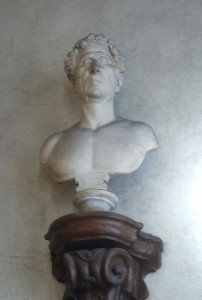Oriens: The Journal of the Ecclesia Dei Society of Australia
https://www.oriensjournal.com
Winter 1999
The temptation to tidiness
———————————————————————————————————————————————-
“THERE ARE many mansions in my Father’s house,” so says Our Lord. “If
there were not I should have told you.”
The metaphor of the Church as God’s household is an attractive one. We
live in a rambling old house that has rooms both in time and in
eternity. It has rooms full of apparently useless junk, kitchens,
dining rooms, rooms to sleep in, rooms just to sit around in, rooms
for fun, rooms for quiet, solemn rooms of State and rooms to drink
wine and sing songs in. The important point is that the rooms in God’s
household are for His family, and that there is a place for everyone.
It has been a sign of authentic Catholic faith throughout the ages to
allow God’s family to dwell in His house undisturbed by unnecessary
demands for moral or doctrinal conformity.
The heretics have generally been the puritans, fanatics and purists.
The Catholics generally had the softer approach to life. The heretics
were always wanting to clean up the house like Martha, the Catholics
content to put up their feet and chat with the head of the household
like Mary. The Catholic attitude to life should be just a little bit
irresponsible and perhaps even scandalous, rather like the Church’s
founder.
The Traditional Movement because of its unfortunate marginalisation is
always in danger of this temptation to tidiness which historically has
not been the characteristic of a Catholic outlook but of a heterodox
one. The Church of Christ has never been tidy, efficient or well
organised. Catholics, with some notable exceptions, have never been
very good, for example, at running wars or bureaucracies. This is as
it should be since the Church’s job is to get people into heaven, not
to wash or scrub them or to make them into model citizens of whatever
sort.
This should also be the aim of the Traditional Movement which should
be content to live in the vast and rambling mansions of God and to
encourage others to do so. More frequently than we would like to
admit, however, we traditionalists can see ourselves as bouncers at
the front door keeping out the riff raff who might make the place
untidy. The rules for admission, however, were laid down by Our Divine
Founder in embarrassingly minimal terms: “Come to me all you who
labour and are heavy burdened and I will give you rest.” There are
four gospels, seven sacraments and ten commandments. All the rest is
optional.
Integrist temptation
There is a tendency among traditional Catholics to see Tradition as
one big package of religious, social and political conservatism. Those
who do not accept this whole package can then be portrayed as
inconsistent and not really Traditional at all, just eclectic
cafeteria Catholics who happen to like incense and chant, as mere
aesthetes who just like dressing up or even in more alarming terms as
agents or infiltrators of unseen sinister forces trying to subvert the
Church.
Neither…nor…
The fact is, however, that the traditional movement cannot impose any
other agenda than that of the Church itself. It can be neither
republican nor monarchist. It cannot take a line on which is the best
way to advance the pro-life cause. It does not have a view on gun
control. It neither condemns nor approves home schooling. It does not
have a line on the privatisation of public utilities. It is neither
capitalist nor socialist. It does not and cannot endorse or condemn
any political party. It can only encourage individuals to follow the
Church’s teaching on Faith and Morals and to promote them in the
public forum. To require more of people than the Church requires is to
make ourselves more Catholic than the Pope and more Christian than
Christ.
If traditional Catholics, moreover, are to accept the whole of the
Church’s teaching then we must also recognise the Church’s traditional
teaching on social and political matters. For over a hundred years the
Popes have spoken in encyclical after encyclical about the rights of
workers, about the injustices associated with debt and the
centralisation of economic power. We cannot ignore the consistent
teaching of the Popes from Leo XIII’s Rerum Novarum to Pope John Paul
II’s Centesimus Annus. To do so would be to embrace the very same
“cafeteria mentality” of the progressives that is so often condemned
in traditional circles.
The Church’s social teaching should not be seen as a regrettable
family secret that we try to keep anyone else from finding out about.
There is no contradiction between a desire to see a restoration of
liturgical and doctrinal Tradition and a lively interest in the issues
of social justice so consistently urged upon us by the Magisterium of
the Church. One might indeed hope, that the alienation felt by many
traditional Catholics as a result of the manifest injustices that many
of us have suffered would lend us a certain sense of solidarity with
the poor and dispossessed.
Interior coherence
There is furthermore an interior coherence between the Truth of Christ
expressed so purely and so eloquently in the traditional Mass and our
refusal to accept the deceptions of the dictators and despots of this
world. The traditional Mass is much more difficult for the world to
subvert. It cannot easily become propaganda for any party. In its easy
and expansive silences Truth is easily nurtured in the soul and the
whispered lies of tyrants die. In that hospitable silence the peasant
may kneel next to the king, and the only measure between them is that
of personal holiness, and God keeps that secret in the recesses of His
own mystery.
The traditional Mass is indeed the Mass of God’s rambling and
welcoming mansions into which it is our happy duty to invite all of
His scattered sons and daughters.
—–
For more on this subject, see this talk given three years ago in
Oklahoma by the Abbot of Fontgombault:



